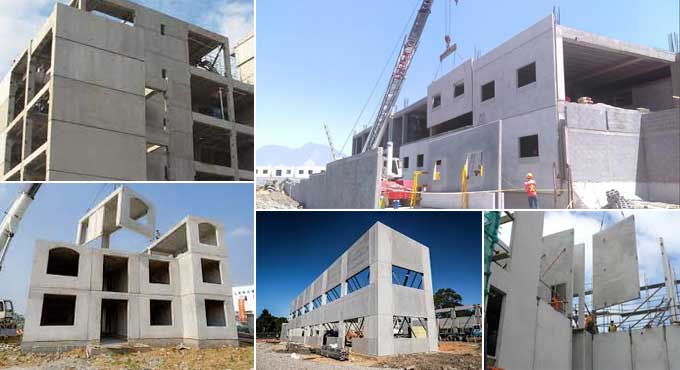
Precast Concrete: Types & Processes
Various shapes of precast concrete designs fit into parts of an overall structure under the term precast concrete. Before placing them in their proper position, separate forms construct to construct them. Concrete members are cast or poured at the final position of the structure in formwork. In prefabricated construction, precast concrete uses to construct buildings.
1. Manufacturing Process of Precast Concrete
Main Process
The mold was provided and assembled. In the case of pre-stressed concrete elements, you can place the reinforcement cage in position and stressing the wires. Whenever necessary, you can attach tubes and inserts.
Concrete is poured into the molds. The concrete is vibrated and finished. You are stacking the cured products after removing the forms and removing the units from the molds. Curing has been completed. It is preferable to use steam curing.
Auxiliary Process
A mixing station or a batching plant is used for proportionally mixing ingredients and for creating fresh concrete. Prefabrication of reinforcement cages is carried out in steelyards or workshops.
Precast units require inserts and other finishing items. It is your responsibility to finish the precast products. Test these products and arrange for their testing.
Subsidiary Process
Keeping concrete ingredients and other materials in a storage facility is essential. You can arrange the delivery of materials such as aggregates, sand, and cement. The green concrete and reinforcement cages are transported to the molding yard.
After products are finished, they are stacked in a stacking yard. In addition to repairing machines and tools, you have to maintain them. Steam is used for curing.
2. Managerial Responsibilities of Quality Concrete Checking
When making precast concrete, you must employ a cyclic technological method to achieve speed and economy. You need to improve quality and productivity, and you must improve mechanization. It is essential to produce quality elements to be able to achieve maximum production.
If you want to meet the demand, you need to maintain speed. The working conditions for those in the workforce must improve. It is possible to minimize production interruptions caused by weather and other factors.
3. Various Types of Precast Concrete Units
Lintel Units
Over windows, doors, and passageways, prefabricated RCC lintels provide a convenient alternative. By eliminating the curing period, precast lintels indirectly speed up construction.
The most popular RCC lintel type for small spaces is precast, cast in wooden molds, and cured well in advance.
If precast lintels are placing, they should have their marked faces facing upward. A marker or paint is always applied to the top of precast lintels to differentiate them from the bottom. Otherwise, the reinforcement will be placed in the wrong place, resulting in structural failure.
Concrete Blocks of Hollow
A wall or column construct from hollow blocks. For maximum economic use of full-length and half-length blocks during construction, the overall wall length and height should fix so that they complement each other. While selecting the height of door and window openings, you should take into account the size of hollow blocks available.
Throughout the building industry, special shapes manufacture for corners, sills, lintels, jambs, as well as wall closings and piers between doors and windows.
Roofing & Flooring Elements
The timber battens replace with prefabricated reinforced concrete battens. Concrete trusses may use for sloping roofs made of precast reinforced concrete or pre-stressed concrete. Tiles made from plain precast concrete can use to cover flat roofs or to cover floors.
Shell Units of Precast
Precast shell roofing can make of concrete that is plain or lightly reinforced. The shell unit is cast on a suitable frame. It covers with hessian cloth. Sags are added to the cloth to keep the shell in shape. A thin frame with a height of 2.5 cm uses to regulate the thickness.
Sunshade
The cantilevered end of the sunshade is 75 mm long, tapering upward up to the lintel depth. Monolithic and with a lintel, they are made of solid rock. It projects to be between 60 and 90 cm on average. Rods are typically 8 mm in diameter and spaced 10 cm apart for the sunshade's cantilever, with distributors 4 mm in diameter and spaced 15 cm apart.
Window & Door Frames
You can prefabricate window and door frames as well. Through the frames of the doors and windows are steel bars about 4-40 mm in diameter.
Hinges fixed using suitable hardwood blocks. That ensures a durable mix by vibrating the concrete on a table vibrator and then pouring it into the mold.
Pros of Precast Concrete
- The use of the same formwork is advantageous when casting identical parts.
- It is possible to produce concrete of superior quality by exercising better quality control in the yard and factory.
- It is possible to produce smoother exposed surfaces without plastering.
- If adequate protection is provided in the casting yard, pre-casting can be done in all weather conditions.
- It is relatively easy to make precast units into the required shape.
- It is possible to dismantle them without breaking them.
- A more efficient and economic way of treating can be found.
- It is possible to build in most climatic conditions.
- Buildings may be constructed at a greater speed.
Cons of Precast Concrete
- Handling, transporting, and erecting large structures require specialized equipment. The issue is especially problematic for larger units like beams, slabs, and columns.
- A skilled workforce and mechanized construction may increase construction costs.
- As a result, precast units are more likely to be damaged during loading, transport, and erection.
- Making different types of units work together as per design can be quite complicated, especially if there are different types of units involved.
- Modification of a precast building is difficult in the future.
To get more details, watch the following video tutorial.
Video Source: Oldcastle Infrastructure


